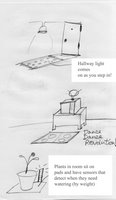While I was pleased for all the qualified entrants-- almost 1000 this year, a record probably due to having a website -- I was most happy about the two student category winners. Jeremy Connell, a junior in Virginia, actually used SolidWorks for his cargo carrier design. Here he is holding the paper edition of NASA Tech Briefs, which features his winning design on the front cover!
 Jeremy would like to get a job designing boats. I'm also hoping he'll intern at SolidWorks if he's available and we can work out the details.
Jeremy would like to get a job designing boats. I'm also hoping he'll intern at SolidWorks if he's available and we can work out the details.
The winner for the Transportation design category was student Corban Tillman-Dick, who is actually an economics major at Johns Hopkins. He's the designer of a more efficient engine, the Internally Radiating Impulse Engine. His brothers were all present for the award; they are trying to get funding to base a company on this design. Sadly, their father, who helped with the design, died suddenly in a car accident a few weeks earlier and could not attend with them. Here is Corban and a brother with Jeff Ray, CEO of SolidWorks:
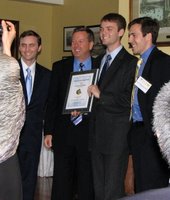
A few other winners -- Joseph Hollman designed a beacon locator for mine workers, shortly after a serious mining disaster last year. Here is Joseph receiving his award:
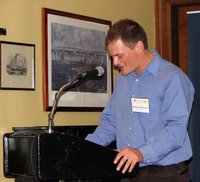
And Dr. Ajay Mahajan and colleagues were there to receive their Medical category prize for a 3D ultrasonic neuronavigation system for realtime image guided brain surgery.
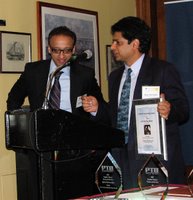
I'm afraid my camera batteries, bought for €1 in a Venice shop, did not hold out long enough for everyone's prize.
As you may recall, I was the consultant that designed and project managed the contest site for SolidWorks. This was the first year that SolidWorks was a major sponsor, as well as the first year there was any website featuring visible entries (and featuring a frenetic, viral "page view contest" which galvanized many students, not to mention bots). Jeff Ray also accepted the SolidWorks award for "Product of the Year" given by readers of NASA Tech Briefs, entirely coincidental with the co-sponsorship of the Create the Future Design Contest. (Obviously the contest was not judged based on software used by any entrant, and SolidWorks did not participate in the judging in any way.) Instead of a boring talking shot of Jeff Ray, I like this pic of him talking over drinks to our student winner who used SolidWorks.
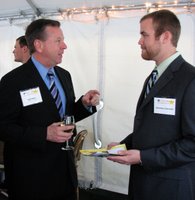
Apart from the chance to see the sometimes wacky but always creative inventions, I got a lot out of seeing young designers do so well in the contest up against professional engineers. And in general, there were a lot of ideas that could make the world a better place with the right exposure and funding. Providing webspace for inventions and inventors is a good thing for us to do. We'll (and I'll) be doing the site and contest again this year! Stay tuned for another June launch.

 When I got home, I came up with a few "nice" and possibly more interesting uses for their weight sensitive technology, instead of threatening their fleeced guests.
When I got home, I came up with a few "nice" and possibly more interesting uses for their weight sensitive technology, instead of threatening their fleeced guests.
